Unveiling the 30 Best AI Tools for 2024
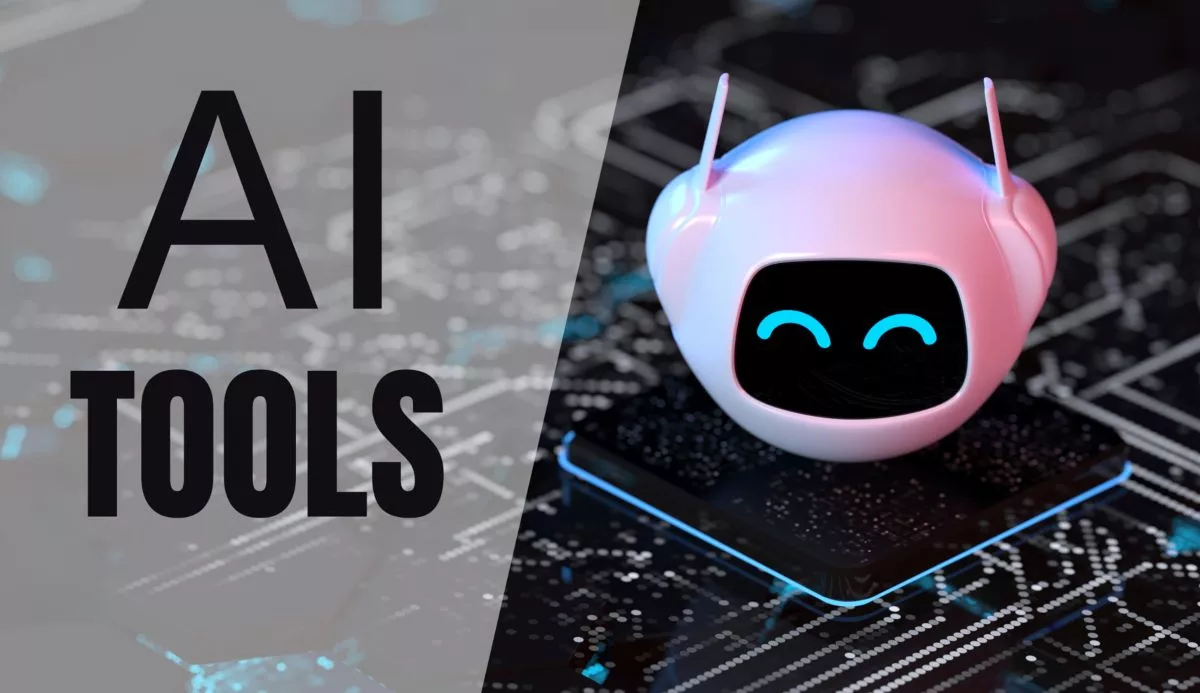
Contents
- 1 Introduction
- 2 Understanding AI Tools
- 3 AI Tools in Business Transformation
- 4 Categories of AI Tools
- 5 Machine Learning Tools: 1-10
- 6 Natural Language Processing (NLP) Tools: 11-20
- 7 Automation Tools: 21-30
- 8 Future Trends in AI Tools
- 9 Conclusion
- 10 Frequently Asked Questions (FAQs)
- 10.1 Q1. What criteria should I consider when selecting an AI tool for my business?
- 10.2 Q2. How can AI tools enhance the decision-making process in a business?
- 10.3 Q3. Are there any privacy concerns associated with the use of AI tools?
- 10.4 Q4. How can businesses address bias and fairness in AI tools?
- 10.5 Q5. Which industries are anticipated to experience the most significant impact from AI in 2024?
Introduction
In the fast-changing world of technology, artificial intelligence (AI) is at the forefront, ready to change how we live and work. As we step into 2024, the realms of AI are expanding at an unprecedented pace, promising a future where intelligent machines and algorithms will become integral to our daily lives.
Brief Overview of AI in 2024
As of 2024, AI has transcended its status as a mere technological novelty, becoming an indispensable force across various sectors. From healthcare to finance, education to manufacturing, the influence of AI is pervasive, transforming the efficiency and capabilities of industries. Breakthroughs in machine learning, natural language processing, and computer vision have propelled AI into new frontiers, enabling machines to learn, adapt, and make decisions with human-like intelligence.
The Significance of AI Tools in Various Industries
One of the cornerstones of AI’s impact is the proliferation of AI tools, which have become instrumental in streamlining processes and enhancing productivity across diverse industries. These tools range from sophisticated analytics platforms to advanced robotics, each tailored to address specific challenges within its domain. For instance, in healthcare, AI tools aid in diagnostic accuracy and drug discovery, while in manufacturing, they optimize production lines and predictive maintenance.
The transformative power of AI tools is evident in their ability to analyze vast datasets, identify patterns, and derive actionable insights. This not only expedites decision-making processes but also opens new avenues for innovation and problem-solving. Companies leveraging AI tools gain a competitive edge by harnessing the potential of data-driven intelligence, leading to enhanced efficiency and strategic decision-making.
Anticipation and Excitement for the Upcoming AI Tools
The pace of AI innovation shows no signs of slowing down, and there is palpable anticipation for the wave of upcoming AI tools. Researchers and developers worldwide are working tirelessly to create tools that push the boundaries of what AI can achieve. Whether it’s advancements in natural language understanding, more sophisticated autonomous systems, or novel applications in fields like climate science or space exploration, the future promises a cascade of AI tools that will redefine what we thought possible.
As we delve into the details of these forthcoming AI tools in the following sections, it becomes clear that we are on the brink of a new era—one where the synergy between human intelligence and artificial intelligence reshapes industries, fosters innovation, and propels us into uncharted technological frontiers. The journey into the heart of AI tools in 2024 is a testament to the boundless potential of human ingenuity, as we navigate a future where AI becomes an indispensable ally in our pursuit of progress.
Understanding AI Tools
Definition and Scope
AI tools, in simple terms, are smart computer programs that help us do things better and faster. They’re like helpful digital assistants that use advanced technology to learn, think, and make decisions. The scope of AI tools is vast—they’re used in many areas like healthcare, finance, and manufacturing to solve problems and make processes smoother.
Evolution of AI Tools from 2022 to 2024
From 2022 to 2024, AI tools have come a long way. They’ve evolved to be even smarter and more useful. Think of it like upgrading from an old phone to the latest model with lots of new features. AI tools now do things we couldn’t have imagined a few years ago, making our lives and work much more efficient.
Key Features to Look for in AI Tools
When choosing AI tools, it’s important to know what features to look for. Imagine picking a superhero for a mission—you’d want one with the right powers. Similarly, good AI tools have key features. They can analyze big sets of information, find patterns, and give us useful insights. The best ones can adapt to new situations and make decisions that help us succeed. When exploring AI tools, keep an eye out for these superpowers that can make a big difference in how you work and solve problems.

AI Tools in Business Transformation
Enhancing Efficiency and Productivity
AI tools play a superhero role in business, boosting efficiency and productivity. Just like a super-speedy sidekick, these tools help companies do tasks faster and better. For example, in manufacturing, AI tools can optimize how products are made, reducing time and costs. This efficiency boost allows businesses to focus on what they do best while letting AI handle the repetitive or complex tasks.
Impact on Decision-Making Processes
Imagine having a wise advisor by your side when making tough decisions—that’s how AI tools impact decision-making in business. These tools analyze lots of information quickly, helping leaders make smart choices. In finance, for instance, AI tools can predict market trends, assisting investors in making informed decisions. This ability to analyze data and provide insights transforms decision-making, making it more accurate and strategic.
Case Studies of Successful AI Integration
Real-world examples highlight the success of AI tools in transforming businesses. Consider a delivery company using AI to optimize routes, ensuring packages reach their destinations faster and with fewer delays. This not only enhances customer satisfaction but also reduces costs for the company. In healthcare, AI tools aid in diagnosing diseases more accurately, improving patient outcomes. These case studies show how businesses across various industries are reaping the benefits of integrating AI tools into their operations.
AI tools aren’t just tech gadgets; they’re powerful allies reshaping how businesses operate. By enhancing efficiency, influencing decision-making, and showcasing success stories, these tools become integral in the transformation journey, helping businesses thrive in the ever-evolving landscape.
Categories of AI Tools
Machine Learning Platforms
Machine Learning Platforms are like smart learners in the digital world. They are tools that help computers learn from data and improve their performance over time. It’s similar to teaching a robot to recognize objects—it gets better with practice. These platforms are used in various fields, such as predicting trends in finance or recognizing patterns in healthcare data. Machine learning platforms make AI smarter by enabling it to learn and adapt on its own.
Natural Language Processing Tools
Natural Language Processing (NLP) Tools are like language wizards for computers. They help machines understand and interact with human language, almost like teaching them to speak our language. Think of it as a translation tool, but much smarter. In customer service, for example, NLP tools can understand and respond to customer queries, making communication between humans and machines more natural and effective. These tools are essential for making AI user-friendly and accessible.
Automation Tools
Automation Tools are the superheroes of efficiency. They take over repetitive tasks, freeing up human time for more meaningful work. Picture a robot assistant handling routine office tasks, allowing humans to focus on creative and complex projects. Automation tools are used in manufacturing, business processes, and even at home. They streamline workflows, reduce errors, and increase productivity. Essentially, they’re like a helping hand that never gets tired.
These categories of AI tools—Machine Learning Platforms, Natural Language Processing Tools, and Automation Tools—each bring a unique set of skills to the table. From learning and adapting to understanding human language and automating tasks, these tools contribute to the diverse and powerful toolkit of AI, making it an indispensable part of our technological landscape.
Machine Learning Tools: 1-10
1. TensorFlow
TensorFlow is like the brainpower behind many smart machines. It’s an AI tool that helps computers process information and make decisions, much like how our brains work. Here are some key points about TensorFlow:
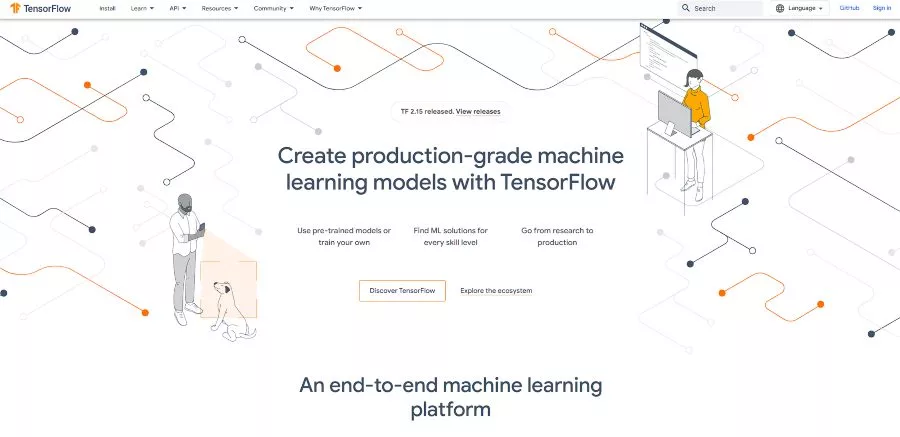
1. What is TensorFlow?
- TensorFlow is an open-source machine learning library. Think of it as a library of tools and resources that helps computers learn and perform tasks without being explicitly programmed.
2. How Does TensorFlow Work?
- It works by using neural networks, which are structures inspired by the human brain. These networks learn from data and make predictions or decisions. TensorFlow provides the tools to create and train these neural networks.
3. Where is TensorFlow Used?
- It’s used in various fields like healthcare, finance, and technology. In healthcare, TensorFlow can analyze medical images to assist in diagnosis. In finance, it helps predict market trends. In technology, it’s used for speech recognition and language processing.
4. Why is TensorFlow Important?
- TensorFlow is crucial because it makes complex tasks easier for computers. It’s like giving them a powerful toolkit to solve problems on their own. This tool is especially important in AI because it enables developers to build and train advanced machine learning models.
5. User-Friendly and Versatile
- Despite its powerful capabilities, TensorFlow is designed to be user-friendly. It allows developers to work with high-level APIs, making it accessible for a wide range of users, from beginners to experts. Its versatility makes it suitable for various AI applications.
6. Community and Innovation
- TensorFlow boasts a big and lively group of developers and researchers. This means constant updates, improvements, and a wealth of resources for those working with AI tools. The community contributes to the innovation and evolution of TensorFlow.
TensorFlow is a powerhouse in the world of AI tools. It empowers machines to learn and perform tasks, making it an integral part of the toolkit for developers working on AI applications across different industries.
2. Scikit-learn
Scikit-learn is like a helpful guide for machines, assisting them in learning and making decisions. It’s an AI tool that simplifies the process of building and using machine learning models. Let’s explore Scikit-learn in more detail:
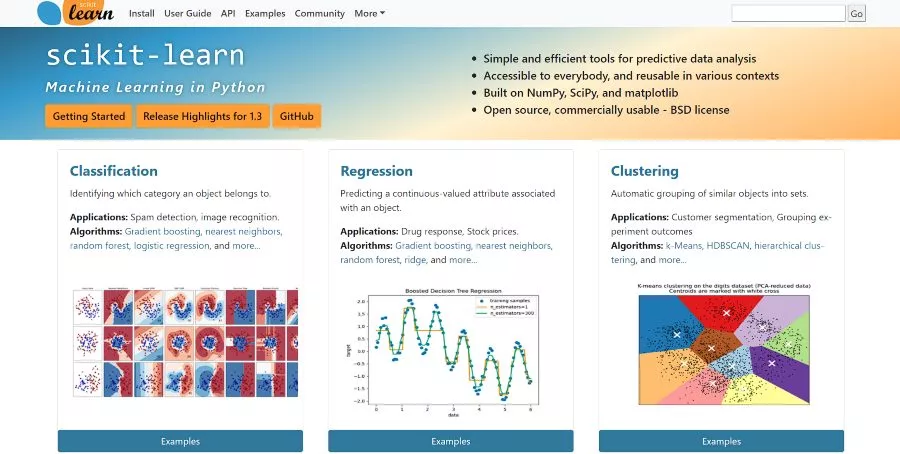
1. What is Scikit-learn?
- Scikit-learn is an open-source machine learning library. Think of it as a toolkit that provides ready-to-use tools for tasks like classification, regression, clustering, and more. It’s designed to be user-friendly, making it easier for developers to implement machine learning in their projects.
2. How Does Scikit-learn Work?
- It simplifies complex tasks by offering pre-built functions and algorithms. For instance, if you want a computer to recognize patterns in data, Scikit-learn provides the tools to do that without starting from scratch. It’s like having a set of building blocks to create intelligent systems.
3. Where is Scikit-learn Used?
- Scikit-learn finds applications in various fields, including healthcare, finance, and science. In healthcare, it might help analyze patient data for better diagnosis. In finance, it could assist in predicting market trends. Its versatility makes it valuable across different domains where machine learning is applied.
4. Why is Scikit-learn Important?
- Scikit-learn is crucial because it saves time and effort for developers. Instead of writing complex code for every machine learning task, they can use Scikit-learn’s tools. This makes it accessible for a wide range of developers, from beginners to experts, contributing to the widespread adoption of machine learning.
5. User-Friendly and Extensible
- Like TensorFlow, Scikit-learn is designed to be user-friendly. Its simple and consistent interface allows developers to focus on the task at hand rather than getting bogged down by technical complexities. Moreover, it’s extensible, meaning developers can build upon its foundation for more customized solutions.
6. Facilitating Machine Learning for Everyone
- Scikit-learn plays a role in making machine learning accessible to a broader audience. Its ease of use and versatility empower developers to integrate machine learning into their projects, fostering innovation and advancements in AI across industries.
Scikit-learn serves as a valuable AI tool, providing a straightforward way for developers to implement machine learning in their projects. Its user-friendly design and applicability across various domains contribute to the democratization of machine learning, making it a key player in the realm of AI tools.
3. PyTorch
PyTorch is like a creative artist’s toolkit for machines, allowing them to learn, adapt, and create. It’s an AI tool, much like TensorFlow, designed to make building and training deep learning models more accessible. Let’s explore PyTorch in more detail:

1. What is PyTorch?
- PyTorch is an open-source machine learning library. Think of it as a set of tools that enables computers to learn from data and make decisions. It’s particularly popular for its flexibility and dynamic computation graph, which allows developers to create and modify models on the fly.
2. How Does PyTorch Work?
- PyTorch uses dynamic computation graphs, a fancy term that essentially means it allows for more flexibility in building and modifying models. Imagine you’re crafting a recipe and can adjust it as you go—PyTorch allows developers to do something similar with machine learning models.
3. Where is PyTorch Used?
- PyTorch finds applications in various fields, from computer vision to natural language processing. For example, in computer vision, PyTorch helps machines recognize and understand images. In natural language processing, it aids in language understanding, making interactions between computers and humans more intuitive.
4. Why is PyTorch Important?
- PyTorch is important because it provides a dynamic and intuitive way to work with deep learning models. Its “eager execution” mode allows developers to see results instantly, making the process of building and debugging models more straightforward. This flexibility is especially valuable for researchers and developers experimenting with new ideas.
5. User-Friendly and Research-Focused
- PyTorch is known for being user-friendly, making it easier for developers to experiment with different models and ideas. Its interface is more akin to writing Python code, which is familiar to many developers. This characteristic makes it a popular choice, particularly in research settings where experimentation is key.
6. Advancing AI Research
- PyTorch has played a significant role in advancing AI research. Its dynamic computation graph and ease of use have attracted researchers who want to quickly prototype and experiment with new models. This has contributed to the rapid evolution of AI capabilities and the development of more sophisticated models.
PyTorch is a powerful tool in the world of AI, offering flexibility and ease of use for developers and researchers. Its dynamic nature and focus on experimentation contribute to the ongoing advancements in AI research and its practical applications across various domains.
4. Keras
Keras is like a friendly guide that simplifies the journey of creating artificial intelligence. It’s an AI tool that focuses on making the process of building neural networks, a key aspect of AI, more accessible and user-friendly. Let’s delve into Keras in more detail:

1. What is Keras?
- Keras is a high-level neural networks API. Think of it as a helpful layer on top of other AI tools, allowing developers to build and experiment with neural networks without diving into complex details. It’s created to be easy for users and work efficiently.
2. How Does Keras Work?
- Keras acts as a bridge to other deep learning libraries, like TensorFlow or Theano. It provides a simplified interface, enabling developers to create and train neural networks with just a few lines of code. It’s like having a shortcut that makes the journey of creating AI models quicker and more straightforward.
3. Where is Keras Used?
- Keras is widely used in various applications, from image recognition to natural language processing. For instance, in image recognition, Keras helps in training models to identify objects in pictures. In natural language processing, it aids in tasks like language understanding and text generation.
4. Why is Keras Important?
- Keras is important because it abstracts away the complexities of building neural networks. It allows developers to focus on the creative aspects of AI without getting bogged down by technical intricacies. This accessibility makes it a popular choice for those who want to quickly prototype and experiment with AI ideas.
5. User-Friendly and Intuitive
- Keras is known for its simplicity and user-friendly design. Its syntax is easy to understand, making it a great entry point for beginners in the world of AI. Developers can express their ideas in a clear and concise manner, translating their concepts into functional AI models without a steep learning curve.
6. Facilitating Rapid Prototyping
- Keras facilitates rapid prototyping of AI models. It allows developers to iterate quickly, trying out different architectures and ideas. This quick experimentation is valuable in the creative process of AI development, enabling developers to refine and improve their models efficiently.
Keras acts as a valuable tool in the realm of AI, providing a simplified and user-friendly interface for building neural networks. Its focus on accessibility and rapid prototyping makes it a go-to choice for developers seeking a smooth journey in the creative and dynamic field of artificial intelligence.
5. Microsoft Azure Machine Learning
Microsoft Azure Machine Learning is like a powerful wizard for AI, offering a comprehensive platform for building, training, and deploying intelligent models. It’s an AI tool designed by Microsoft to make the process of working with machine learning accessible to developers and businesses. Let’s explore the key aspects of Microsoft Azure Machine Learning:
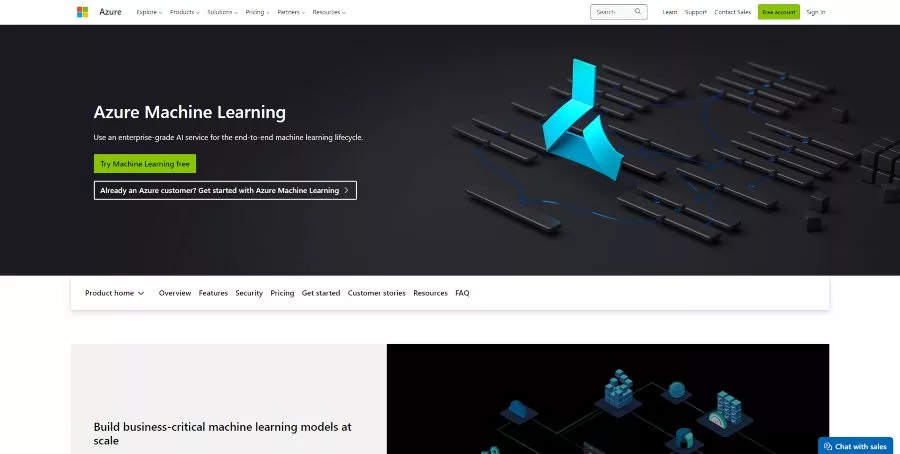
1. What is Microsoft Azure Machine Learning?
- Microsoft Azure Machine Learning is a cloud-based service that empowers users to develop and deploy machine learning models. Think of it as a one-stop shop that provides all the tools and resources needed to bring AI projects to life.
2. How Does Microsoft Azure Machine Learning Work?
- It simplifies the machine learning journey by offering a range of tools and services. From data preparation to model training and deployment, Azure Machine Learning streamlines the entire process. It’s like having a virtual workshop equipped with everything needed to craft intelligent solutions.
3. Where is Microsoft Azure Machine Learning Used?
- This tool is used across various industries, from finance and healthcare to manufacturing. For instance, in finance, it might help in predicting financial trends. In healthcare, it could be used to analyze patient data for better treatment outcomes. It can be used in various situations because of its flexibility.
4. Why is Microsoft Azure Machine Learning Important?
- Microsoft Azure Machine Learning is important because it brings the power of AI to the cloud. It allows businesses and developers to harness the capabilities of machine learning without investing heavily in infrastructure. This accessibility is a game-changer, democratizing AI and making it available to a broader audience.
5. User-Friendly and Scalable
- Azure Machine Learning is designed to be user-friendly, with a user interface that simplifies complex tasks. Additionally, it scales easily, meaning it can handle projects of various sizes. Whether you’re a solo developer or part of a large enterprise, Azure Machine Learning adapts to your needs.
6. Enabling Intelligent Solutions at Scale
- Azure Machine Learning is not just about building models; it’s about deploying them at scale. This makes it a key player in creating intelligent solutions that can impact a wide range of users and scenarios. It’s like turning AI ideas into real-world applications.
Microsoft Azure Machine Learning is a robust AI tool that extends the power of machine learning to the cloud. Its user-friendly design, scalability, and versatility make it a valuable asset for businesses and developers, opening doors to the creation of intelligent solutions across different industries.
6. IBM Watson Studio
IBM Watson Studio is like a genius assistant for AI, providing a collaborative environment for data scientists, developers, and business analysts to work together on AI projects. It’s an AI tool developed by IBM, aiming to streamline the process of creating and deploying machine learning models. Let’s explore the key features of IBM Watson Studio:

1. What is IBM Watson Studio?
- IBM Watson Studio is a comprehensive platform designed to simplify the lifecycle of AI and data science projects. Think of it as a virtual workspace where teams can collaborate seamlessly to build, train, and deploy intelligent models.
2. How Does IBM Watson Studio Work?
- It facilitates collaboration by offering tools for data preparation, model development, and deployment. Whether you’re a data scientist exploring patterns or a business analyst interpreting results, Watson Studio provides a shared space for everyone involved in the AI journey.
3. Where is IBM Watson Studio Used?
- This tool finds applications in various domains, from finance and healthcare to marketing. For example, in finance, it might assist in fraud detection. In healthcare, it could help analyze patient records for better treatment strategies. Its versatility caters to different industries and their specific AI needs.
4. Why is IBM Watson Studio Important?
- IBM Watson Studio is important because it bridges the gap between different roles in AI projects. It allows data scientists, developers, and business analysts to collaborate effectively, ensuring that AI solutions align with business goals. This collaborative approach enhances the efficiency and effectiveness of AI development.
5. User-Friendly and Collaborative
- Watson Studio is designed with user-friendliness in mind. Its interface is intuitive, making it accessible for various skill levels. Moreover, it fosters collaboration by providing tools that facilitate communication and shared insights, ensuring that the entire team is on the same page.
6. Empowering Teams for AI Success
- Beyond individual tasks, Watson Studio empowers teams to achieve AI success. By providing a centralized hub for collaboration, it accelerates the development process and allows teams to leverage collective expertise. It’s like having a digital workshop where everyone contributes to the creation of intelligent solutions.
IBM Watson Studio serves as a collaborative powerhouse in the realm of AI tools. Its user-friendly design and emphasis on collaboration make it an essential platform for teams working on diverse AI and data science projects across industries.
7. XGBoost
XGBoost is like a wizard for predicting the future, especially when it comes to making decisions based on data. It’s an AI tool that excels in boosting the performance of machine learning models, particularly in predictive analytics. Let’s delve into the key aspects of XGBoost:

1. What is XGBoost?
- XGBoost stands for eXtreme Gradient Boosting. Think of it as a powerful tool that enhances the accuracy of predictions in machine learning models. It’s widely used for tasks like classification and regression, where making accurate predictions is crucial.
2. How Does XGBoost Work?
- XGBoost works by combining the predictions of multiple weak models to create a strong and accurate model. It’s like having a team of experts who specialize in different areas, and together they make better decisions. This method is called ensemble learning.
3. Where is XGBoost Used?
- XGBoost is applied in various fields, from finance and healthcare to marketing. For instance, in finance, it might be used to predict stock prices. In healthcare, it could help in diagnosing diseases based on patient data. Its versatility makes it a go-to choice for predictive analytics across different industries.
4. Why is XGBoost Important?
- XGBoost is important because it significantly improves the accuracy of predictions. Its ability to handle complex relationships in data and its efficiency in processing information make it a valuable asset for data scientists and analysts. This leads to more reliable insights and decisions.
5. User-Friendly and High-Performance
- XGBoost is designed to be user-friendly, offering a simple interface for developers to integrate it into their machine learning projects. Despite its simplicity, it delivers high-performance results, making it suitable for both beginners and experienced data scientists.
6. Boosting Predictive Power
- XGBoost excels in boosting the predictive power of models. It’s like having a crystal ball that helps machines make more accurate predictions. By combining the strengths of multiple models, XGBoost enhances the overall performance of predictive analytics.
XGBoost is a potent tool in the realm of AI, specifically tailored for boosting the predictive accuracy of models. Its simplicity, versatility, and ability to handle complex relationships in data make it a valuable asset for those seeking more accurate and reliable predictions in various industries.
8. IBM Watson Machine Learning
IBM Watson Machine Learning is like a smart coach for your AI models, providing a platform to create, train, and deploy machine learning models at scale. It’s an AI tool developed by IBM, designed to empower businesses and developers in their journey to implement and scale AI solutions. Let’s explore the key features of IBM Watson Machine Learning:
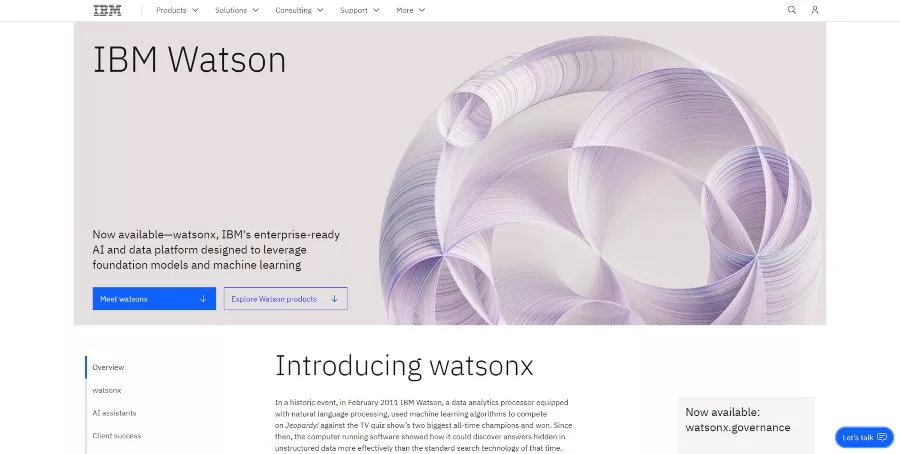
1. What is IBM Watson Machine Learning?
- IBM Watson Machine Learning is a thorough platform that makes deploying and managing machine learning models easier. Think of it as a digital assistant that helps you take your AI models from development to real-world applications seamlessly.
2. How Does IBM Watson Machine Learning Work?
- It streamlines the machine learning workflow, providing tools for data preparation, model building, and deployment. Whether you’re a data scientist creating models or a business analyst deploying them, Watson Machine Learning offers a unified environment for collaboration.
3. Where is IBM Watson Machine Learning Used?
- This tool finds applications across industries, from retail and finance to healthcare. For example, in retail, it might help in predicting customer preferences. In healthcare, it could assist in analyzing patient data for personalized treatment plans. Its versatility caters to different sectors and their specific AI needs.
4. Why is IBM Watson Machine Learning Important?
- IBM Watson Machine Learning is crucial because it simplifies the complex process of deploying machine learning models. It allows businesses to integrate AI into their operations with ease, accelerating the adoption of intelligent solutions. This accessibility is key to leveraging the benefits of AI in diverse scenarios.
5. User-Friendly and Scalable
- Watson Machine Learning is designed with user-friendliness in mind. Its interface is intuitive, making it accessible for various roles within a team. Moreover, it’s scalable, meaning it can handle projects of varying sizes, from small-scale experiments to large-scale AI deployments.
6. Facilitating Collaboration and Deployment
- Beyond model creation, Watson Machine Learning facilitates collaboration and deployment. It’s like a bridge that connects data scientists, developers, and business analysts, ensuring that the entire team can contribute to the success of AI projects. This collaborative approach enhances the effectiveness of AI solutions.
IBM Watson Machine Learning serves as a versatile and user-friendly AI tool, providing a unified platform for the creation, training, and deployment of machine learning models. Its emphasis on collaboration and scalability makes it an essential asset for businesses and developers looking to implement AI solutions across different industries.
9. LightGBM
LightGBM is like a swift and efficient problem-solver for data, specifically designed to tackle tasks related to machine learning and analytics. It’s an AI tool that falls under the category of gradient boosting frameworks, emphasizing speed and performance. Let’s explore the key aspects of LightGBM:

1. What is LightGBM?
- LightGBM, short for Light Gradient Boosting Machine, is a powerful tool for building machine learning models. Think of it as a fast and nimble assistant that excels in processing large datasets and making accurate predictions.
2. How Does LightGBM Work?
- LightGBM employs a technique called gradient boosting, which involves combining the strengths of multiple weak models to create a robust and accurate model. It’s like assembling a team of specialists, each contributing their unique expertise to solve a problem. This ensemble approach enhances the overall performance of the model.
3. Where is LightGBM Used?
- LightGBM is applied in various domains, from finance and marketing to healthcare. For example, in marketing, it might be used for predicting customer behavior. In healthcare, it could help analyze patient data for more accurate diagnoses. Its versatility makes it a valuable asset for predictive analytics in different industries.
4. Why is LightGBM Important?
- LightGBM is important because of its speed and efficiency. It excels in processing large volumes of data quickly, making it suitable for tasks where swift decisions are crucial. Its ability to handle complex relationships in data contributes to the creation of accurate and reliable models.
5. User-Friendly and High-Performance
- LightGBM is designed to be user-friendly while delivering high-performance results. Its interface is intuitive, allowing developers to work efficiently. Despite its simplicity, it’s a high-powered tool that achieves impressive results, making it accessible for both beginners and experienced data scientists.
6. Boosting Predictive Accuracy
- LightGBM, through its gradient boosting approach, significantly boosts the predictive accuracy of models. It’s like having a skilled team that collectively outperforms individual efforts. This makes LightGBM a go-to choice for tasks where precision and speed are paramount.
LightGBM stands out as a fast and efficient AI tool, specializing in predictive analytics and machine learning tasks. Its emphasis on speed, versatility, and boosting predictive accuracy positions it as a valuable asset for data scientists and analysts working across different industries.
10. Amazon SageMaker
Amazon SageMaker is like a versatile workshop for AI, providing a comprehensive set of tools to build, train, and deploy machine learning models. It’s an AI tool developed by Amazon Web Services (AWS), designed to simplify the end-to-end process of working with machine learning. Let’s explore the key features of Amazon SageMaker:
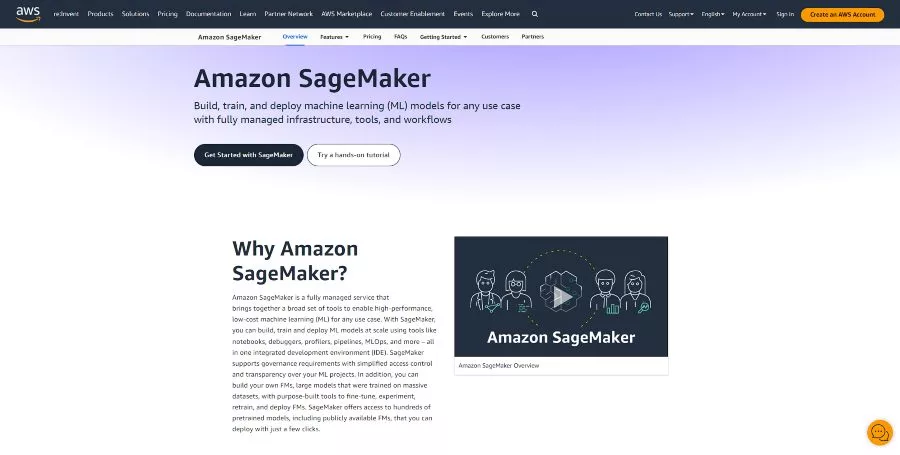
1. What is Amazon SageMaker?
- Amazon SageMaker is a fully-managed service that streamlines the machine learning workflow. Think of it as an all-in-one solution that offers tools for every stage of the machine learning journey, from data preparation to model deployment.
2. How Does Amazon SageMaker Work?
- It provides a unified environment for data scientists and developers, offering pre-configured notebooks for coding, training models at scale, and deploying them to production. SageMaker simplifies complex tasks, making it easier to experiment, build, and operationalize machine learning models.
3. Where is Amazon SageMaker Used?
- This tool finds applications in various industries, including e-commerce, finance, and healthcare. For example, in e-commerce, SageMaker might be used for predicting customer preferences. In healthcare, it could assist in analyzing patient data for better treatment strategies. Its adaptability caters to different business needs.
4. Why is Amazon SageMaker Important?
- Amazon SageMaker is important because it democratizes machine learning. It allows businesses to harness the power of AI without the need for extensive expertise. Its fully-managed nature and seamless integration with AWS services contribute to the widespread adoption of machine learning.
5. User-Friendly and Scalable
- SageMaker is designed with user-friendliness in mind. Its interface is intuitive, making it accessible for various skill levels. Additionally, it’s scalable, enabling businesses to handle machine learning projects of different sizes and complexities.
6. Enabling Rapid Experimentation and Deployment
- Amazon SageMaker facilitates rapid experimentation with machine learning models. It’s like having a dynamic workshop where ideas can be quickly tested and refined. Moreover, its deployment capabilities ensure that successful models can be seamlessly integrated into real-world applications.
Amazon SageMaker stands as a powerful and user-friendly AI tool, offering a holistic solution for businesses and developers working on machine learning projects. Its versatility, scalability, and emphasis on simplifying the machine learning workflow make it a valuable asset for organizations across various industries.
Natural Language Processing (NLP) Tools: 11-20
11. SpaCy
SpaCy is like a language maestro for computers, specializing in Natural Language Processing (NLP). It’s an AI tool designed to make understanding and working with human language a breeze. Let’s explore the key aspects of SpaCy:
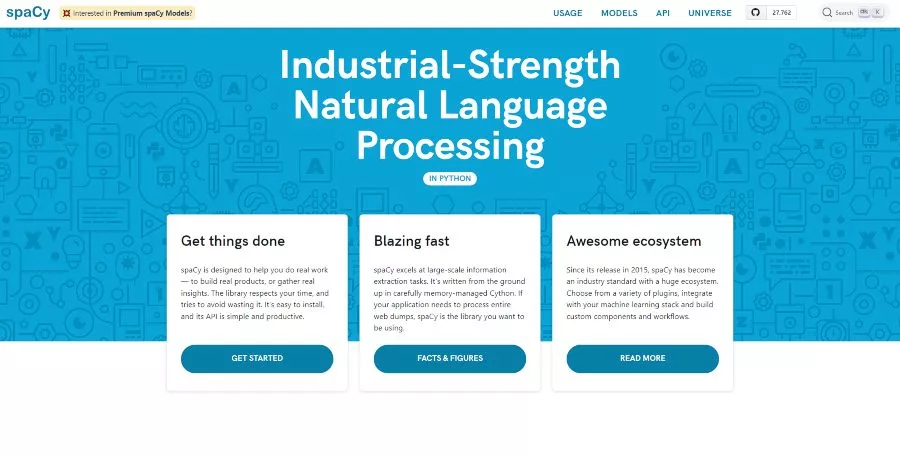
1. What is SpaCy?
- SpaCy is a library for Natural Language Processing, which is like giving computers the ability to understand and interact with human language. Think of it as a language toolkit that equips machines with the skills to comprehend and analyze text.
2. How Does SpaCy Work?
- It uses advanced algorithms to process and understand text, breaking it down into components like words, sentences, and entities. SpaCy can identify parts of speech, extract key information, and even discern the relationships between different elements in a sentence.
3. Where is SpaCy Used?
- SpaCy finds applications in various fields, from chatbots and virtual assistants to sentiment analysis and information extraction. For example, in a chatbot, SpaCy helps in understanding and responding to user queries. In sentiment analysis, it assists in gauging the mood conveyed in a piece of text.
4. Why is SpaCy Important?
- SpaCy is crucial because it simplifies complex language tasks for machines. Its efficiency in language processing makes it a valuable tool for developers and businesses looking to incorporate NLP into their applications. This efficiency is key to creating more natural and intelligent interactions between humans and machines.
5. User-Friendly and Precise
- SpaCy is designed to be user-friendly, offering an intuitive interface for developers to work with. Its precision in language analysis ensures accurate results, making it a reliable choice for those who want to leverage NLP without delving into the intricacies of language processing.
6. Enhancing Communication and Understanding
- SpaCy plays a vital role in enhancing communication between humans and machines. It enables computers to understand context, extract meaningful information, and respond intelligently. This makes it a fundamental component in the toolkit of AI developers working on language-centric applications.
SpaCy stands out as a versatile and precise AI tool, particularly in the realm of Natural Language Processing. Its ability to unravel the complexities of human language equips developers with the means to create more intelligent and responsive applications across a wide range of industries.
12. NLTK (Natural Language Toolkit)
NLTK, or the Natural Language Toolkit, is like a language guide for computers, specializing in Natural Language Processing (NLP). It’s an AI tool designed to empower developers and researchers with a set of resources and algorithms for working with human language. Let’s explore the key aspects of NLTK:
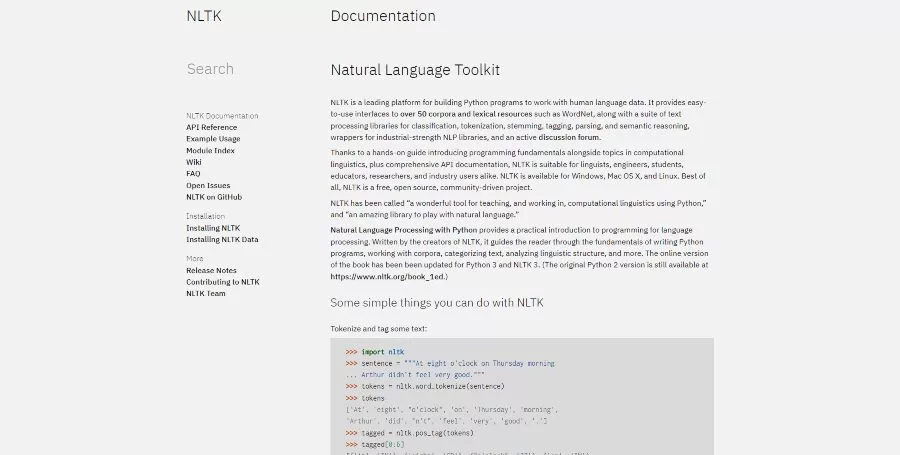
1. What is NLTK?
- NLTK, short for Natural Language Toolkit, is a library for Natural Language Processing. Think of it as a toolbox filled with tools and techniques that enable machines to understand, interpret, and generate human language.
2. How Does NLTK Work?
- NLTK provides a collection of algorithms and resources for various language processing tasks. It covers everything from tokenization and stemming to part-of-speech tagging and sentiment analysis. Developers can leverage these tools to analyze and manipulate text data with ease.
3. Where is NLTK Used?
- NLTK finds applications in diverse areas, from information retrieval and text classification to machine translation. For instance, in information retrieval, NLTK helps in extracting relevant information from large sets of documents. In machine translation, it aids in translating text between different languages.
4. Why is NLTK Important?
- NLTK is important because it democratises NLP. It provides a comprehensive set of tools that make language processing accessible to developers with varying levels of expertise. Its open-source nature and extensive documentation contribute to the widespread adoption of NLP in various projects.
5. User-Friendly and Educational
- NLTK is designed to be user-friendly, offering clear and understandable implementations of NLP algorithms. Additionally, it serves as an educational resource, providing learning materials and examples that help developers understand the intricacies of natural language processing.
6. Empowering Language Exploration and Analysis
- NLTK empowers developers and researchers to explore the depths of language. Whether it’s dissecting the structure of a sentence or analyzing the sentiment behind words, NLTK provides the tools to delve into the nuances of human communication, fostering advancements in language-related AI applications.
NLTK stands as a versatile and educational AI tool, particularly in the realm of Natural Language Processing. Its role as a language toolkit provides developers with the means to unravel the complexities of human language, making it an indispensable resource for projects spanning various industries.
13. BERT (Bidirectional Encoder Representations from Transformers)
BERT, or Bidirectional Encoder Representations from Transformers, is like a language genius among AI tools, transforming the way machines understand context in human language. It’s an advanced model for Natural Language Processing (NLP) that has reshaped the landscape of language understanding. Let’s explore the key aspects of BERT:
1. What is BERT?
- BERT is a sophisticated language model designed for NLP. Its full name, Bidirectional Encoder Representations from Transformers, gives a hint about its unique ability to understand the context of words by considering both the left and right context in a sentence.
2. How Does BERT Work?
- BERT leverages a transformer architecture, a powerful neural network design. What makes BERT stand out is its bidirectional approach, allowing it to analyze a word’s meaning by considering the words that come before and after it. This bidirectional understanding enables more accurate comprehension of context.
3. Where is BERT Used?
- BERT finds applications in various language-related tasks, from text classification and sentiment analysis to question answering and language translation. For instance, in question answering, BERT excels at understanding the context of a question and providing accurate answers.
4. Why is BERT Important?
- BERT is crucial because it addresses the limitations of previous models by considering the full context of a sentence. This bidirectional approach significantly improves the accuracy of language understanding, making it a cornerstone in the development of advanced NLP applications.
5. Enhancing Contextual Understanding
- BERT’s bidirectional nature enhances contextual understanding. It’s like giving machines the ability to read between the lines, understanding the nuances and subtleties of human language. This capability is key to creating more natural and intelligent interactions between machines and users.
6. Advancing Language Understanding in AI
- BERT represents a significant advancement in the field of NLP. Its ability to capture context has led to breakthroughs in various language-related tasks, pushing the boundaries of what machines can achieve in understanding and processing human language.
BERT stands as a pioneering AI tool in the realm of Natural Language Processing. Its bidirectional approach to language understanding has revolutionized the field, paving the way for more accurate and context-aware applications across a spectrum of industries.
14. GPT (Generative Pre-trained Transformer)
GPT, or Generative Pre-trained Transformer, is like a creative writer among AI tools, capable of understanding and generating human-like text. It’s an advanced language model that has made waves in the world of Natural Language Processing (NLP). Let’s delve into the key aspects of GPT:

1. What is GPT?
- GPT stands for Generative Pre-trained Transformer, a state-of-the-art language model in the realm of NLP. Think of it as a virtual wordsmith that has been trained on massive amounts of text data to understand and generate human-like language.
2. How Does GPT Work?
- GPT leverages a transformer architecture, a powerful neural network design. What sets GPT apart is its pre-training on vast datasets, allowing it to learn the nuances of language. Through pre-training, GPT gains the ability to produce text that is both coherent and contextually relevant when given specific prompts.
3. Where is GPT Used?
- GPT finds applications in various creative and analytical tasks, from content generation and storytelling to language translation and code completion. For instance, in content generation, GPT can be used to automatically create articles or stories based on a given theme or topic.
4. Why is GPT Important?
- GPT is important because of its ability to generate high-quality and contextually relevant text. Its pre-training on diverse datasets equips it with a deep understanding of language patterns, making it a valuable tool for a wide range of applications that involve generating human-like text.
5. Enabling Creative Text Generation
- GPT excels at creative text generation. It’s like having an AI-powered storyteller that can craft engaging narratives, poems, or articles. This creativity extends to various domains, making GPT a versatile tool for those seeking AI assistance in content creation.
6. Transforming Language Capabilities
- GPT represents a transformation in language capabilities for AI. Its proficiency in understanding and generating text has implications for content creation, conversational AI, and other language-driven applications, making it a driving force in advancing NLP.
GPT stands as a groundbreaking AI tool in the domain of Natural Language Processing. Its pre-trained nature and creative text generation capabilities make it a valuable asset for applications requiring human-like language understanding and generation across diverse industries.
15. Word2Vec
Word2Vec is like a language wizard among AI tools, transforming words into numerical representations to enhance language understanding. It’s a technique in Natural Language Processing (NLP) that plays a crucial role in capturing semantic relationships between words. Let’s explore the key aspects of Word2Vec:
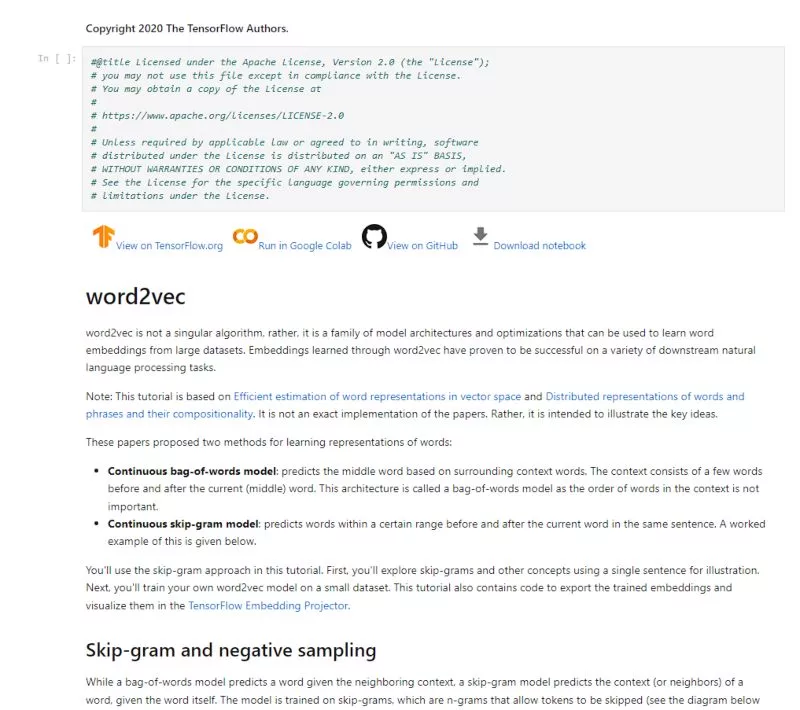
1. What is Word2Vec?
- Word2Vec is a technique that converts words into vectors of numerical values. Think of it as a translator that turns words into a language machines can understand, facilitating more effective processing of textual information.
2. How Does Word2Vec Work?
- Word2Vec operates on the principle that words with similar meanings should have similar numerical representations. By analyzing the context in which words appear in a large dataset, Word2Vec creates vector representations that capture semantic relationships. This allows machines to understand the meaning and context of words.
3. Where is Word2Vec Used?
- Word2Vec finds applications in various language-related tasks, including document similarity, sentiment analysis, and recommendation systems. For instance, in sentiment analysis, Word2Vec helps machines grasp the sentiment behind words and phrases, leading to more accurate analysis of textual content.
4. Why is Word2Vec Important?
- Word2Vec is important because it bridges the gap between language and numerical processing. Its ability to convert words into vectors enables machines to comprehend the nuanced relationships between words, contributing to more sophisticated language understanding in AI applications.
5. Enhancing Semantic Understanding
- Word2Vec excels at enhancing semantic understanding. It’s like providing machines with a map of word meanings, allowing them to navigate the intricacies of language. This semantic understanding is crucial for tasks that require capturing the subtleties and nuances of human communication.
6. Empowering Language Processing
- Word2Vec empowers language processing by providing machines with a method to understand and represent words in a meaningful way. This is fundamental for applications where precise interpretation of language is required, making Word2Vec a valuable tool in the AI toolkit.
Word2Vec stands as a pivotal technique in the realm of Natural Language Processing. Its role in converting words into numerical representations significantly contributes to the enhancement of language understanding in AI tools, enabling more accurate and nuanced processing of textual information.
16. OpenNLP
OpenNLP is like a language guide for computers, aiding in Natural Language Processing (NLP) tasks with a set of tools and algorithms. It’s an AI tool designed to dissect and understand the intricacies of human language. Let’s delve into the key aspects of OpenNLP:

1. What is OpenNLP?
- OpenNLP stands for Open Natural Language Processing. Think of it as a toolbox filled with tools and algorithms to help machines comprehend and analyze human language. It’s designed to make language processing accessible and efficient.
2. How Does OpenNLP Work?
- OpenNLP employs various algorithms for tasks like sentence detection, tokenization, part-of-speech tagging, and named entity recognition. It’s like giving machines a set of linguistic tools to break down and understand different aspects of text.
3. Where is OpenNLP Used?
- OpenNLP finds applications in diverse areas, from information extraction and sentiment analysis to chatbots and language translation. For instance, in chatbots, OpenNLP helps in understanding and responding to user queries by breaking down sentences into meaningful components.
4. Why is OpenNLP Important?
- OpenNLP is important because it streamlines language processing tasks. Its set of tools enables developers to tackle common NLP challenges without having to build algorithms from scratch. This accessibility makes it a valuable asset for projects involving language understanding.
5. User-Friendly and Versatile
- OpenNLP is designed to be user-friendly, providing a straightforward interface for developers to work with. Its versatility allows it to be applied in various contexts, making it suitable for different NLP applications across industries.
6. Facilitating Language Understanding
- OpenNLP plays a crucial role in facilitating language understanding for machines. It’s like providing a language interpreter that assists computers in breaking down and interpreting the meaning behind words and sentences, contributing to more effective communication.
OpenNLP serves as a practical and versatile AI tool in the field of Natural Language Processing. Its set of tools and algorithms empowers developers to enhance language understanding in applications, making it an essential component in the toolkit of AI tools for various language-related tasks.
17. AllenNLP
AllenNLP is like a sophisticated language scholar among AI tools, providing a comprehensive framework for Natural Language Processing (NLP) tasks. It’s an advanced tool designed to assist developers and researchers in building and deploying state-of-the-art NLP models. Let’s explore the key aspects of AllenNLP:

1. What is AllenNLP?
- AllenNLP, short for Allen Natural Language Processing, is a robust framework for developing and deploying NLP models. Think of it as a toolset that empowers developers to create advanced language models without delving into the complexities of model architecture.
2. How Does AllenNLP Work?
- AllenNLP simplifies the NLP model development process by providing pre-built components and abstractions. Developers can leverage these components to create custom models, focusing on the specific tasks they want to solve, whether it’s text classification, named entity recognition, or question answering.
3. Where is AllenNLP Used?
- AllenNLP finds applications in various NLP tasks across different domains, including healthcare, finance, and customer service. For instance, in healthcare, it might be used for extracting medical information from clinical texts. In customer service, it could assist in understanding and responding to user queries.
4. Why is AllenNLP Important?
- AllenNLP is important because it accelerates the development of advanced NLP models. Its modular design and pre-built components save time and effort for developers, allowing them to focus on the specific challenges of their projects. This efficiency makes it a valuable asset in the world of NLP.
5. User-Friendly and Modular
- AllenNLP is designed to be user-friendly, offering a modular and extensible architecture. Its components can be combined and customized to suit different NLP tasks, making it accessible for developers with varying levels of expertise.
6. Advancing NLP Capabilities
- AllenNLP contributes to advancing NLP capabilities by providing a framework that supports the development of cutting-edge models. Its flexibility and adaptability make it a preferred choice for researchers and developers aiming to push the boundaries of what is possible in language understanding.
AllenNLP stands as a powerful and user-friendly AI tool in the realm of Natural Language Processing. Its role in simplifying the development of advanced language models positions it as a valuable asset for those working on NLP tasks across diverse industries.
18. TextBlob
TextBlob is like a language companion among AI tools, offering a simplified and versatile way to perform Natural Language Processing (NLP) tasks. It’s an accessible and user-friendly tool designed to make language analysis and processing straightforward for developers and researchers. Let’s delve into the key aspects of TextBlob:

1. What is TextBlob?
- TextBlob is a tool in Python designed to handle and process textual data. Think of it as a handy assistant that provides a set of tools and functionalities to analyze and manipulate text, making it a go-to choice for developers working on language-related tasks.
2. How Does TextBlob Work?
- TextBlob simplifies common NLP tasks like part-of-speech tagging, noun phrase extraction, sentiment analysis, classification, translation, and more. It’s like a Swiss Army knife for language processing, offering a range of features that can be easily integrated into Python applications.
3. Where is TextBlob Used?
- TextBlob finds applications in various projects, including social media sentiment analysis, content categorization, and language translation. For example, in sentiment analysis, TextBlob helps determine the sentiment expressed in a piece of text, whether it’s positive, negative, or neutral.
4. Why is TextBlob Important?
- TextBlob is important because it brings simplicity to language processing. Its user-friendly interface and straightforward integration make it accessible for developers with different levels of expertise. This accessibility contributes to the widespread adoption of TextBlob in NLP projects.
5. User-Friendly and Versatile
- TextBlob is designed to be user-friendly, offering a simple and intuitive API for text analysis. Its versatility allows it to handle various NLP tasks without the need for intricate configurations, making it a valuable tool for quick and efficient language processing.
6. Enabling Easy Language Analysis
- TextBlob plays a crucial role in enabling easy and effective language analysis. It’s like having a language expert that can quickly extract information, identify key elements, and provide insights from textual data, empowering developers to focus on the analysis rather than the intricacies of the tools.
TextBlob stands as a versatile and user-friendly AI tool in the domain of Natural Language Processing. Its simplicity and rich set of features make it an essential companion for developers and researchers working on a wide range of language-related projects across different industries.
19. CoreNLP (Stanford CoreNLP)
CoreNLP, or Stanford CoreNLP, is like a linguistic powerhouse among AI tools, offering a comprehensive suite of natural language processing capabilities. It’s an advanced tool developed by Stanford University, designed to analyze and understand the intricacies of human language. Let’s explore the key aspects of CoreNLP:
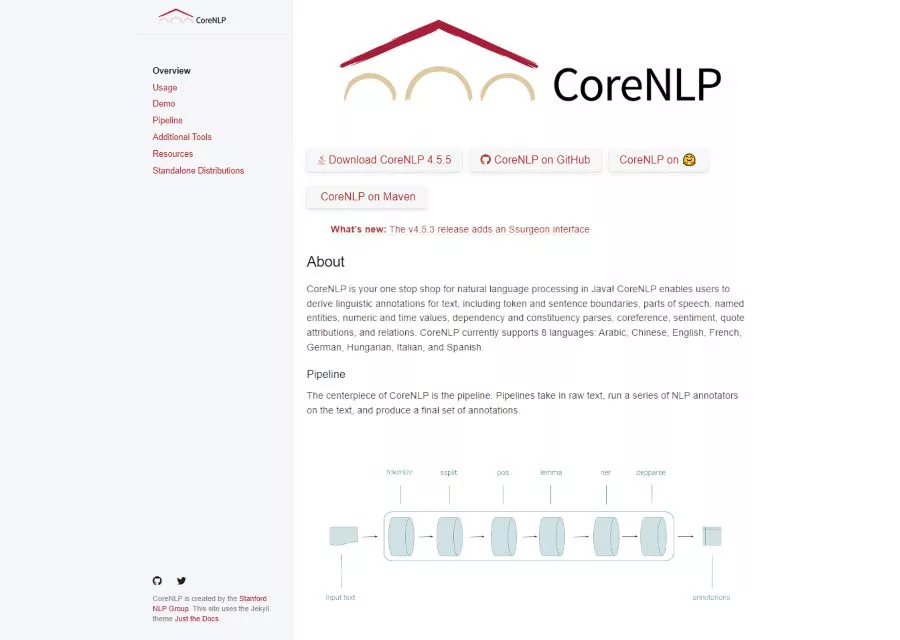
1. What is CoreNLP?
- CoreNLP, also known as Stanford CoreNLP, is a sophisticated natural language processing toolkit. Think of it as a linguistic Swiss Army knife equipped with a variety of tools to analyze text, extract information, and unveil the structural nuances of language.
2. How Does CoreNLP Work?
- CoreNLP employs a range of algorithms for tasks like part-of-speech tagging, named entity recognition, sentiment analysis, and more. It’s like having a virtual linguist that can break down sentences, identify entities, and provide valuable insights into the meaning and structure of text.
3. Where is CoreNLP Used?
- CoreNLP finds applications in diverse areas, including information extraction, sentiment analysis, and question answering. For instance, in information extraction, CoreNLP helps in identifying and extracting relevant information from unstructured text, making it valuable for various industries.
4. Why is CoreNLP Important?
- CoreNLP is important because it offers a comprehensive set of linguistic tools that go beyond basic language analysis. Its capabilities, developed by Stanford University, make it a reliable choice for projects that demand a deeper understanding of language structures and semantics.
5. Robust and Academic Heritage
- CoreNLP boasts a robust and academic heritage, benefitting from research and development at Stanford University. This heritage ensures that it incorporates cutting-edge advancements in natural language processing, making it a tool of choice for both academic and practical applications.
6. Unveiling Language Structures
- CoreNLP plays a crucial role in unveiling the intricate structures of language. It’s like having a guide that can navigate the complexities of sentences, identify grammatical elements, and reveal the layers of meaning embedded in textual data.
CoreNLP stands as a powerful and comprehensive AI tool in the domain of Natural Language Processing. Its range of tools and its academic foundation from Stanford University make it a go-to choice for developers and researchers seeking advanced linguistic capabilities for various language-related tasks across industries.
20. Rasa
Rasa is like a conversation maestro among AI tools, providing a platform for building open-source conversational agents. It’s an advanced tool designed to empower developers to create AI-driven chatbots and virtual assistants with a focus on natural and meaningful interactions. Let’s delve into the key aspects of Rasa:
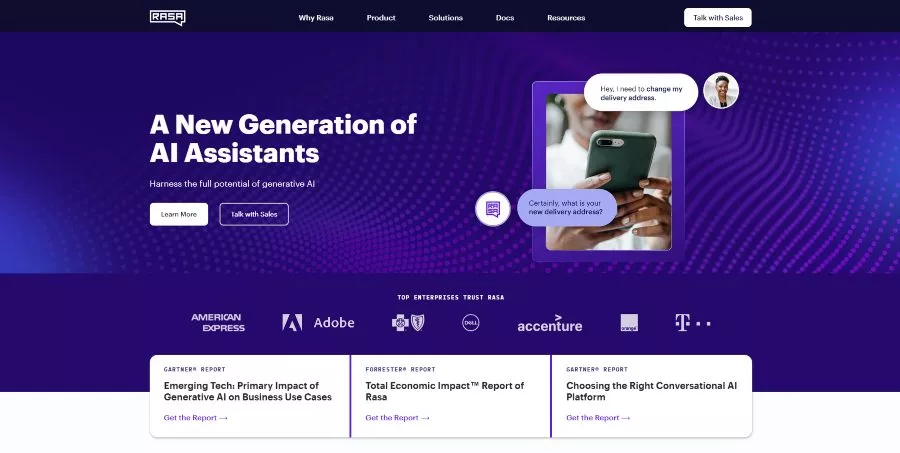
1. What is Rasa?
- Rasa is an open-source framework for building conversational agents. Think of it as a toolkit that equips developers with the tools and resources needed to create chatbots and virtual assistants capable of engaging in dynamic and context-aware conversations.
2. How Does Rasa Work?
- Rasa employs machine learning and natural language processing to comprehend and reply to user inputs. It’s like giving chatbots the ability to comprehend context, handle intents, and provide responses that feel more like natural conversation. Rasa enables developers to build dialogue-driven AI applications.
3. Where is Rasa Used?
- Rasa finds applications in various industries, including customer support, healthcare, and e-commerce. For example, in customer support, Rasa-powered chatbots can assist users in troubleshooting issues by understanding and responding to queries in a conversational manner.
4. Why is Rasa Important?
- Rasa is important because it puts the power of conversation into the hands of developers. Its open-source nature and focus on dialogue-driven interactions make it a valuable tool for those looking to create AI tools that go beyond simple command-response scenarios.
5. User-Centric Conversational AI
- Rasa is designed with a user-centric approach, emphasizing meaningful and context-aware conversations. It’s like having a chatbot that not only understands what users say but also comprehends the context of the conversation, leading to more effective and personalized interactions.
6. Enabling Dynamic Chat Experiences
- Rasa empowers developers to create dynamic chat experiences. It’s like providing a platform to build chatbots that can handle complex dialogues, understand user intents, and adapt their responses based on the flow of the conversation, resulting in more engaging interactions.
Rasa stands as a dynamic and user-centric AI tool in the realm of conversational AI. Its open-source framework and focus on natural dialogue make it a preferred choice for developers aiming to create chatbots and virtual assistants that excel in understanding and responding to user inputs across various industries.
Automation Tools: 21-30
21. UiPath
UiPath is like a digital assistant among AI tools, offering a platform for robotic process automation (RPA). It’s an advanced tool designed to automate repetitive tasks, liberating humans from mundane activities and enhancing overall operational efficiency. Let’s explore the key aspects of UiPath:
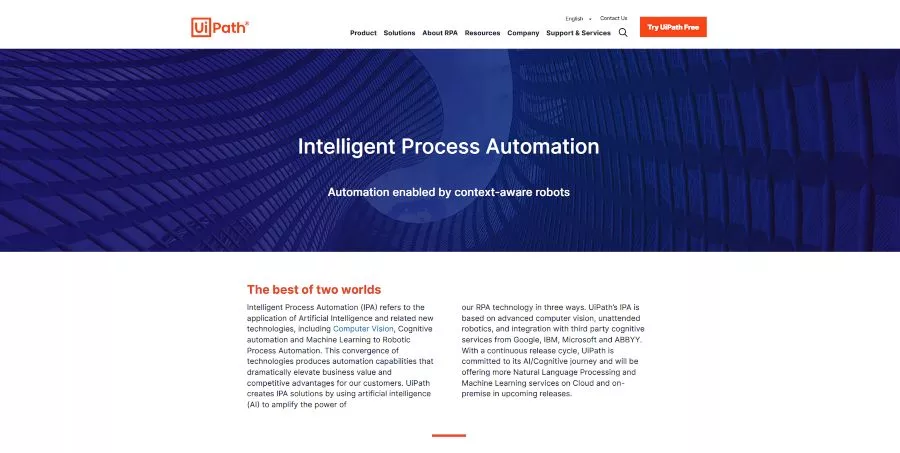
1. What is UiPath?
- UiPath is a leading platform in the realm of robotic process automation. Think of it as a digital workforce that mimics human actions to automate repetitive tasks. UiPath is designed to streamline business processes and optimize workflows through intelligent automation.
2. How Does UiPath Work?
- UiPath uses automation to mimic human interactions with digital systems. It’s like having a digital assistant that can navigate applications, input data, perform calculations, and execute tasks across various software platforms. UiPath’s capabilities extend to both front-end and back-end processes.
3. Where is UiPath Used?
- UiPath finds applications across industries, including finance, healthcare, and manufacturing. For example, in finance, UiPath can automate invoice processing, reducing manual efforts and minimizing errors. In healthcare, it can assist in managing patient records efficiently.
4. Why is UiPath Important?
- UiPath is important because it revolutionizes how businesses handle routine tasks. Its automation capabilities enhance speed, accuracy, and scalability, leading to increased productivity and allowing human workers to focus on more complex and strategic aspects of their roles.
5. Efficiency Through Automation
- UiPath brings efficiency through automation. It’s like having a tireless digital workforce that can tirelessly perform repetitive tasks round the clock, ensuring consistent and error-free execution. This enhanced efficiency results in reduced costs and improved operational effectiveness.
6. Empowering Business Transformation
- UiPath empowers business transformation by automating mundane processes. It’s like providing businesses with a tool to evolve beyond routine tasks, freeing up human resources to focus on innovation and value-added activities that contribute to overall growth and success.
UiPath stands as a transformative AI tool in the domain of automation. Its role in streamlining processes, reducing manual efforts, and enhancing efficiency positions it as a valuable asset for businesses seeking to leverage intelligent automation to achieve operational excellence.
22. Automation Anywhere
Automation Anywhere is like a digital workforce orchestrator among AI tools, providing a platform for intelligent automation. It’s an advanced tool designed to empower businesses to automate a wide range of tasks, fostering efficiency, and driving digital transformation. Let’s explore the key aspects of Automation Anywhere:

1. What is Automation Anywhere?
- Automation Anywhere stands as a powerful platform for intelligent automation. Think of it as a conductor orchestrating a digital workforce that automates tasks, processes data, and executes actions across various applications and systems.
2. How Does Automation Anywhere Work?
- Automation Anywhere utilizes robotic process automation (RPA) to automate repetitive tasks. It’s like having a team of digital workers that can navigate through applications, extract and process data, and perform complex workflows, mimicking human actions but at a much faster pace.
3. Where is Automation Anywhere Used?
- Automation Anywhere finds applications in industries such as finance, healthcare, and logistics. For instance, in finance, it can automate tasks related to data entry and processing, reducing errors and improving accuracy. In healthcare, it can assist in managing administrative processes efficiently.
4. Why is Automation Anywhere Important?
- Automation Anywhere is crucial because it empowers organizations to scale their operations and achieve digital transformation. Its capabilities in automating routine tasks enhance productivity, reduce costs, and allow human workers to focus on strategic and creative aspects of their roles.
5. Scaling Operations with Digital Workers
- Automation Anywhere enables businesses to scale their operations with digital workers. It’s like having a team of tireless assistants that can handle repetitive tasks, allowing human employees to focus on high-value activities that contribute to organizational growth.
6. Driving Digital Transformation
- Automation Anywhere plays a key role in driving digital transformation. It’s like a catalyst that accelerates the adoption of automation technologies, fostering a more agile and efficient business environment that can quickly adapt to evolving industry demands.
Automation Anywhere stands as a transformative AI tool in the category of automation. Its role in orchestrating digital workforces and automating tasks positions it as a valuable asset for businesses aiming to enhance efficiency, reduce operational costs, and embark on the journey of digital transformation.
23. Blue Prism
Blue Prism is like a digital choreographer among AI tools, offering a platform for robotic process automation (RPA). It’s an advanced tool designed to automate and optimize business processes, bringing efficiency and agility to organizational workflows. Let’s delve into the key aspects of Blue Prism:

1. What is Blue Prism?
- Blue Prism is a leading platform in the realm of robotic process automation (RPA). Think of it as a conductor that orchestrates digital workers to automate repetitive tasks, allowing businesses to streamline processes and enhance operational efficiency.
2. How Does Blue Prism Work?
- Blue Prism employs robotic process automation to mimic human interactions with digital systems. It’s like having a team of digital assistants that can navigate applications, manipulate data, and perform tasks across various software platforms, freeing up human workers from routine tasks.
3. Where is Blue Prism Used?
- Blue Prism finds applications across industries, including finance, healthcare, and manufacturing. For example, in finance, it can automate tasks related to data entry and reconciliation, reducing errors and improving accuracy. In healthcare, it can assist in managing administrative processes efficiently.
4. Why is Blue Prism Important?
- Blue Prism is important because it enables organizations to automate complex business processes. Its capabilities in robotic process automation enhance speed, accuracy, and scalability, contributing to increased productivity and allowing human workers to focus on more strategic aspects of their roles.
5. Efficiency Through Digital Workers
- Blue Prism brings efficiency through the deployment of digital workers. It’s like having a workforce that tirelessly performs tasks without errors and at a faster pace, leading to operational excellence and cost savings for businesses.
6. Enhancing Business Agility
- Blue Prism plays a crucial role in enhancing business agility. It’s like providing businesses with a tool to quickly adapt to changing demands by automating processes and workflows, ensuring a more flexible and responsive organizational environment.
Blue Prism stands as a pivotal AI tool in the category of automation. Its role in orchestrating digital workers and automating business processes positions it as a valuable asset for organizations seeking to optimize workflows, reduce operational costs, and enhance overall business efficiency.
24. Zapier
Zapier is like a digital connector among AI tools, providing a user-friendly platform for automating workflows and integrating applications. It’s an intuitive tool designed to empower users, allowing them to automate repetitive tasks and create seamless connections between different software applications. Let’s explore the key aspects of Zapier:
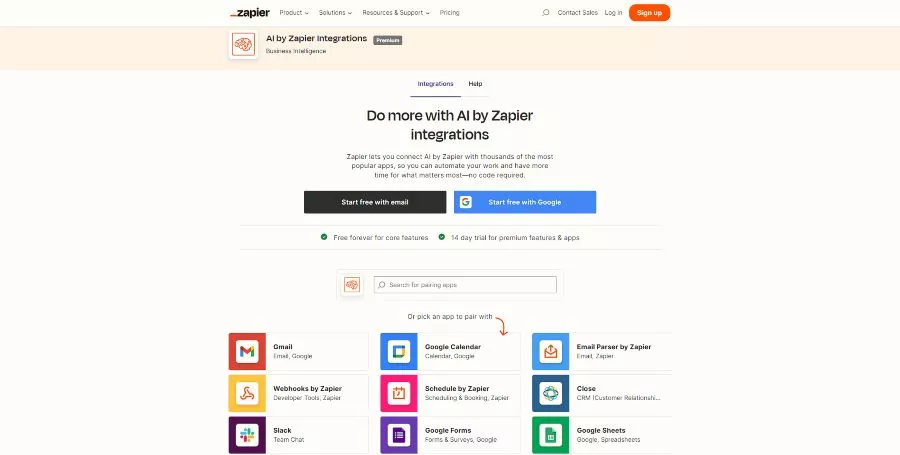
1. What is Zapier?
- Zapier is a versatile platform for automating tasks and connecting applications. Think of it as a virtual bridge that enables users to create automated workflows, called Zaps, linking different apps to enhance productivity and streamline processes.
2. How Does Zapier Work?
- Zapier operates on a simple principle: when a trigger event occurs in one application, it initiates an action in another. It’s like having a digital assistant that follows predefined rules to execute tasks automatically. Users can set up Zaps without any coding knowledge, making automation accessible to everyone.
3. Where is Zapier Used?
- Zapier finds applications across various industries and professions, from marketing and sales to project management and customer support. For instance, in marketing, Zapier can automate the process of adding new leads to a CRM system when they fill out a form on a website.
4. Why is Zapier Important?
- Zapier is crucial because it democratizes automation. Its user-friendly interface allows individuals and businesses to automate tasks without relying on technical expertise. This accessibility fosters efficiency, enabling users to focus on high-value activities.
5. User-Friendly Automation
- Zapier is designed with a focus on user-friendliness. It’s like providing a toolbox for users to create their automated workflows, empowering them to automate repetitive tasks and integrate applications with ease.
6. Streamlining Workflows
- Zapier plays a pivotal role in streamlining workflows. It’s like having a workflow conductor that ensures data flows seamlessly between different applications, reducing manual efforts and creating a more connected and efficient work environment.
Zapier stands as a user-friendly and versatile AI tool in the category of automation. Its role in connecting and automating workflows makes it a valuable asset for individuals and businesses seeking to optimize processes, enhance productivity, and create a more efficient digital workspace.
25. Microsoft Power Automate
Microsoft Power Automate is like a digital choreographer among AI tools, providing a platform for automating workflows and processes seamlessly. It’s an advanced tool designed by Microsoft to empower users to automate repetitive tasks, integrate applications, and enhance overall productivity. Let’s delve into the key aspects of Microsoft Power Automate:

1. What is Microsoft Power Automate?
- Microsoft Power Automate is a versatile platform for automating tasks and processes. Think of it as a digital assistant that enables users to create automated workflows, connecting different applications and services to streamline tasks without the need for extensive coding.
2. How Does Microsoft Power Automate Work?
- Microsoft Power Automate utilizes a user-friendly interface that allows users to create flows, which are automated sequences of actions. It’s like having a set of predefined rules that trigger actions in response to specific events, automating tasks and data flows across various Microsoft and third-party applications.
3. Where is Microsoft Power Automate Used?
- Microsoft Power Automate finds applications in various business scenarios, from data entry automation and approval workflows to integrating data between different software platforms. For instance, it can automate the process of sending email notifications when a new entry is added to a database.
4. Why is Microsoft Power Automate Important?
- Microsoft Power Automate is important because it brings automation capabilities directly into the hands of users. Its intuitive design and integration with Microsoft 365 and other popular services make it accessible for businesses and individuals, fostering productivity and efficiency.
5. User Empowerment Through Automation
- Microsoft Power Automate empowers users by allowing them to automate tasks without relying on extensive technical expertise. It’s like providing a toolkit for users to customize and automate their workflows, reducing manual efforts and saving time.
6. Seamless Integration with Microsoft Services
- Microsoft Power Automate seamlessly integrates with various Microsoft services, including Microsoft 365, SharePoint, and Teams. This integration enhances collaboration and ensures that users can automate tasks within the Microsoft ecosystem with ease.
Microsoft Power Automate stands as a user-centric AI tool in the category of automation. Its role in empowering users to automate workflows, integrate applications, and enhance productivity makes it a valuable asset for businesses and individuals seeking efficient ways to streamline processes in the digital workspace.
26. Ansible
Ansible is like a digital conductor among AI tools, providing an open-source automation platform for managing and orchestrating complex IT environments. It’s a versatile tool designed to simplify tasks, automate processes, and enhance the efficiency of IT operations. Let’s explore the key aspects of Ansible:

1. What is Ansible?
- Ansible is an open-source automation platform that simplifies the management and orchestration of IT infrastructure. Think of it as a virtual conductor that allows users to automate tasks, configuration management, and application deployment across multiple servers and devices.
2. How Does Ansible Work?
- Ansible uses a declarative language to describe system configurations and tasks. It’s like having a set of instructions that specify how systems should be configured. Ansible then automates the process of ensuring that systems align with the defined configurations, making it a powerful tool for IT automation.
3. Where is Ansible Used?
- Ansible finds applications in various IT scenarios, including server provisioning, configuration management, and application deployment. For instance, it can automate the process of setting up and configuring servers, ensuring consistency across an organization’s IT infrastructure.
4. Why is Ansible Important?
- Ansible is important because it simplifies complex IT operations. Its automation capabilities contribute to consistency, efficiency, and scalability in managing IT environments. Ansible allows IT teams to focus on strategic tasks by automating routine and repetitive activities.
5. Declarative Configuration Management
- Ansible’s declarative approach to configuration management is like providing a blueprint for IT infrastructure. Users define the desired state of systems, and Ansible takes care of bringing systems into alignment with that defined state, ensuring a consistent and reproducible environment.
6. Efficiency in IT Operations
- Ansible plays a crucial role in improving efficiency in IT operations. It’s like having an automated assistant that can handle the deployment of applications, update configurations, and manage infrastructure, reducing manual efforts and minimizing the risk of errors.
Ansible stands as a versatile and efficient AI tool in the category of automation. Its role in simplifying IT operations, ensuring consistency, and automating complex tasks positions it as a valuable asset for organizations seeking to streamline and optimize their IT infrastructure management.
27. Jenkins
Jenkins is like a digital orchestrator among AI tools, providing an open-source automation server for building, testing, and deploying software. It’s a powerful tool designed to streamline the continuous integration and continuous delivery (CI/CD) processes, enhancing efficiency and collaboration in software development. Let’s delve into the key aspects of Jenkins:

1. What is Jenkins?
- Jenkins is an open-source automation server that facilitates the automation of software development processes. Think of it as a digital project manager that oversees tasks like building, testing, and deploying software, ensuring a smooth and efficient workflow for development teams.
2. How Does Jenkins Work?
- Jenkins automates the integration and delivery of software by coordinating various development tasks. It’s like having a continuous assistant that monitors changes in a code repository, triggers builds, and tests applications automatically, providing quick feedback to developers.
3. Where is Jenkins Used?
- Jenkins finds applications in software development environments, particularly in CI/CD pipelines. For example, it can automate the process of compiling code, running tests, and deploying applications, ensuring a consistent and reliable approach to software delivery.
4. Why is Jenkins Important?
- Jenkins is important because it accelerates the software development lifecycle. Its automation capabilities reduce manual efforts, increase the speed of development, and contribute to the overall quality of software by providing continuous integration and continuous delivery.
5. Continuous Integration and Delivery
- Jenkins excels in continuous integration and delivery. It’s like having a vigilant overseer that continuously integrates code changes, automates tests, and delivers applications, ensuring that development teams can rapidly and reliably deliver software.
6. Enhancing Collaboration in Development
- Jenkins plays a pivotal role in enhancing collaboration among development teams. It’s like a collaborative hub where developers can automate and share tasks, ensuring a standardized and efficient approach to building, testing, and deploying software.
Jenkins stands as a crucial AI tool in the category of automation, especially in the realm of software development. Its role in automating CI/CD processes, ensuring continuous integration, and facilitating collaboration makes it a valuable asset for development teams aiming to achieve efficiency and speed in their software delivery practices.
28. Puppet
Puppet is like a digital mastermind among AI tools, offering an open-source automation platform for managing and configuring IT infrastructure. It’s a powerful tool designed to automate the provisioning and management of servers, ensuring consistency and efficiency in large-scale IT environments. Let’s explore the key aspects of Puppet:

1. What is a Puppet?
- Puppet is an open-source automation platform that simplifies the management and configuration of IT infrastructure. Think of it as a digital orchestrator that allows users to define and enforce the desired state of servers and applications, ensuring uniformity and reliability across a network.
2. How Does Puppet Work?
- Puppet uses a declarative language to describe the desired configuration of systems. It’s like having a digital architect that ensures servers and applications align with the defined specifications. Puppet automates the process of making adjustments to achieve and maintain the desired state.
3. Where is Puppet Used?
- Puppet finds applications in large-scale IT environments, data centers, and cloud infrastructures. For example, it can automate the configuration of servers, manage software installations, and enforce security policies, providing a standardized approach to IT operations.
4. Why is Puppet Important?
- Puppet is important because it brings order and consistency to complex IT infrastructures. Its automation capabilities contribute to efficiency, reduce manual errors, and enable organizations to scale their operations by automating routine and repetitive tasks.
5. Declarative Infrastructure Management
- Puppet’s declarative approach to infrastructure management is like providing a blueprint for IT environments. Users specify the desired state, and Puppet takes care of ensuring that servers and applications conform to that state, promoting uniformity and reliability.
6. Scalability and Efficiency
- Puppet plays a crucial role in enhancing scalability and efficiency. It’s like having an automated manager that can handle the configuration and management of numerous servers, ensuring that changes are implemented consistently and promptly across the entire infrastructure.
Puppet stands as a powerful AI tool in the category of automation, particularly in the management of IT infrastructure. Its role in enforcing and maintaining the desired state of servers and applications contributes to the efficiency, reliability, and scalability of large-scale IT operations.
29. Chef
Chef is like a digital chef among AI tools, providing an automation platform for configuring and managing IT infrastructure. It’s a powerful tool designed to streamline the deployment and maintenance of servers, ensuring consistency and efficiency in large-scale computing environments. Let’s delve into the key aspects of Chef:

1. What is a Chef?
- Chef is an automation platform that simplifies the configuration and management of IT infrastructure. Think of it as a digital chef that ensures the right ingredients (software and configurations) are combined in the right way across servers, promoting uniformity and reliability.
2. How Does Chef Work?
- Chef uses a declarative approach to configuration management. It’s like having a recipe book where users define the desired state of servers and applications. Chef then automates the process of bringing systems into alignment with the specified configurations, ensuring consistency.
3. Where is Chef Used?
- Chef finds applications in diverse IT environments, including data centers and cloud infrastructures. For example, it can automate the installation of software, manage configurations, and enforce security policies, providing a systematic approach to the deployment and maintenance of servers.
4. Why is Chef Important?
- Chef is important because it brings automation and consistency to complex IT operations. Its capabilities reduce manual efforts, minimize errors, and enable organizations to scale their operations efficiently by automating repetitive tasks associated with server management.
5. Declarative Configuration with Recipes
- Chef’s approach to configuration management involves using recipes to declare the desired state of systems. It’s like providing a set of cooking instructions that Chef follows to ensure each server is configured correctly, promoting standardization and reliability.
6. Efficiency in Server Deployment
- Chef plays a pivotal role in efficient server deployment. It’s like having a chef that orchestrates the process, ensuring that each server is provisioned, configured, and maintained according to the desired specifications, minimizing downtime and operational hiccups.
Chef stands as a potent AI tool in the category of automation, particularly in the realm of IT infrastructure management. Its role in automating the configuration and maintenance of servers contributes to the consistency, reliability, and scalability of large-scale computing environments.
30. Terraform
Terraform is like a digital architect among AI tools, providing an open-source infrastructure as code (IaC) platform for automating the provisioning and management of IT infrastructure. It’s a versatile tool designed to enhance the efficiency and scalability of infrastructure deployment across various cloud providers. Let’s explore the key aspects of Terraform:
1. What is Terraform?
- Terraform is an open-source infrastructure as code (IaC) tool that simplifies the provisioning and management of IT infrastructure. Think of it as a digital architect that allows users to define infrastructure configurations as code, automating the deployment of resources across different cloud environments.
2. How Does Terraform Work?
- Terraform uses a declarative language to describe the desired state of infrastructure. It’s like having a blueprint for an entire environment that includes servers, networks, and other resources. Terraform then automates the process of creating and managing these resources based on the defined configurations.
3. Where is Terraform Used?
- Terraform finds applications in cloud computing environments, enabling users to automate the deployment of infrastructure on platforms like AWS, Azure, and Google Cloud. For example, it can automate the creation of virtual machines, storage, and networking components in a consistent and reproducible manner.
4. Why is Terraform Important?
- Terraform is important because it brings consistency and automation to infrastructure deployment. Its IaC approach allows organizations to define infrastructure configurations as code, promoting version control, collaboration, and efficiency in managing complex IT environments.
5. Infrastructure as Code (IaC) Principles
- Terraform adheres to the principles of Infrastructure as Code. It’s like providing a programming language for infrastructure, allowing users to treat infrastructure configurations like software code, which can be versioned, tested, and shared, ensuring reliability and repeatability.
6. Multi-Cloud Infrastructure Management
- Terraform excels in multi-cloud infrastructure management. It’s like having a tool that abstracts the complexities of different cloud providers, enabling users to define and manage infrastructure in a consistent way across diverse cloud environments.
Terraform stands as a crucial AI tool in the category of automation, especially in the domain of infrastructure as code. Its role in automating and managing infrastructure deployments across various cloud providers contributes to the efficiency, scalability, and consistency of modern IT operations.
Future Trends in AI Tools
As we look ahead, the landscape of AI tools is poised for exciting developments, shaping the way technology influences our lives. Let’s explore some key trends that are expected to unfold in the coming years:

Quantum Computing and AI Synergy
The intersection of quantum computing and artificial intelligence (AI) marks a frontier of innovation. Quantum computers, with their ability to process vast amounts of data simultaneously, hold the promise of significantly enhancing AI capabilities. Unlike classical computers, quantum computers leverage the principles of quantum mechanics, allowing for faster and more complex computations. This synergy is expected to revolutionize AI applications, particularly in areas that demand immense computational power, such as optimization problems and machine learning algorithms.
Combining AI with the Internet of Things (IoT)
The fusion of AI and the Internet of Things (IoT) is set to redefine the way we interact with our connected devices. AI tools will play a pivotal role in extracting meaningful insights from the massive datasets generated by IoT devices. Imagine smart homes that adapt to your preferences intuitively or industrial setups optimizing processes in real-time based on AI-driven analytics. This integration will not only enhance the efficiency of IoT systems but also pave the way for innovative solutions in healthcare, transportation, and smart cities.
Predictions for AI Tools Beyond 2024
Looking further into the future, AI tools are expected to undergo transformative advancements. Predictions include the evolution of more sophisticated natural language processing (NLP) capabilities, enabling AI to understand context and nuances in human communication with greater accuracy. Additionally, AI tools are likely to become more explainable and transparent, addressing concerns around the “black box” nature of some AI algorithms. We anticipate the continued growth of AI in personalized medicine, with tools tailoring treatment plans based on individual genetic profiles.
In the business realm, AI is expected to further streamline decision-making processes, with tools providing actionable insights derived from complex datasets. Human-AI collaboration will become more prevalent, enhancing productivity and creativity across various industries.
The future of AI tools holds the promise of groundbreaking advancements. The synergy with quantum computing, integration with IoT, and ongoing developments beyond 2024 are poised to shape a future where AI becomes an even more integral and impactful part of our technological landscape. As these trends unfold, the potential for positive transformation in how we live, work, and innovate is boundless.
Conclusion
As we draw the curtain on our exploration of AI tools, let’s recap the highlights and peer into the future landscape of this dynamic field.
Recap of the Top AI Tools Discussed
Throughout our journey, we’ve delved into an array of AI tools that are reshaping the technological landscape. From TensorFlow and PyTorch to Jenkins and Terraform, each tool plays a unique role in automating, optimizing, and enhancing various aspects of our digital world. These tools, like digital artisans, contribute to the efficiency, scalability, and innovation that define the current era of technology.
The Future Landscape of AI Tools
Looking ahead, the future of AI tools is poised for unprecedented growth. The convergence of quantum computing and AI promises to unlock new dimensions of computational power. The integration of AI with the Internet of Things (IoT) heralds a realm where our connected devices seamlessly interact with intelligent systems. Beyond 2024, predictions foresee advancements in natural language processing, explainable AI, and personalized medicine. The business landscape will witness further transformation as AI tools evolve to offer deeper insights and foster human-AI collaboration.
Encouragement for Readers to Explore and Adopt AI Solutions
As we navigate the ever-evolving landscape of AI tools, there’s an encouraging invitation for readers to actively explore and adopt these solutions. Whether you’re a developer, business leader, or enthusiast, the world of AI tools presents a vast playground for innovation. Embrace the learning curve, experiment with diverse tools, and envision the ways AI can elevate your projects, businesses, and daily lives. The power of AI tools lies not just in their capabilities but in the creativity and vision of those who wield them.
The journey through AI tools is both a reflection of our current technological prowess and a glimpse into the limitless possibilities that lie ahead. As we bid adieu to this exploration, let the spirit of curiosity and innovation continue to drive our collective journey into the fascinating realm of AI solutions.
Frequently Asked Questions (FAQs)
Q1. What criteria should I consider when selecting an AI tool for my business?
When choosing an AI tool for your business, consider factors such as the tool’s compatibility with your specific needs, ease of integration into existing systems, scalability, user-friendliness, and the level of support provided by the tool’s developers. Assessing these criteria ensures that the AI tool aligns seamlessly with your business objectives.
Q2. How can AI tools enhance the decision-making process in a business?
AI tools contribute to improved decision-making by analyzing vast datasets, identifying patterns, and providing valuable insights. They can automate data processing, offer predictive analytics, and assist in risk assessment. By leveraging AI tools, businesses can make more informed decisions, optimize processes, and stay ahead in dynamic markets.
Q3. Are there any privacy concerns associated with the use of AI tools?
Yes, privacy concerns are a significant consideration in the use of AI tools. It’s crucial to ensure that AI applications adhere to data protection regulations and prioritize user privacy. Businesses should implement robust security measures, transparent data handling practices, and regularly assess and update their AI systems to address evolving privacy challenges.
Q4. How can businesses address bias and fairness in AI tools?
Addressing bias in AI tools requires a proactive approach. Businesses should implement ethical guidelines during the development phase, conduct thorough testing to identify and rectify biases, and prioritize diverse and representative datasets. Ongoing monitoring and transparency in AI algorithms contribute to building fair and unbiased AI systems.
Q5. Which industries are anticipated to experience the most significant impact from AI in 2024?
Various industries are poised to experience substantial impacts from AI in 2024. Sectors such as healthcare, finance, manufacturing, and retail are expected to witness transformative changes. AI tools will contribute to enhanced diagnostics in healthcare, predictive analytics in finance, optimized production processes in manufacturing, and personalized customer experiences in retail.
You May Also Like:
How to Start a Blog – Step By Step Guide For Beginners
30 Best Blogging Resources for Your Blog
Top 25 Freelance Job Websites for Remote Work
Top 20 Money Making Apps You Can’t Miss
18 On-Page SEO Techniques To Rank On First Page
24 Best Free SEO Tools for Your Website




